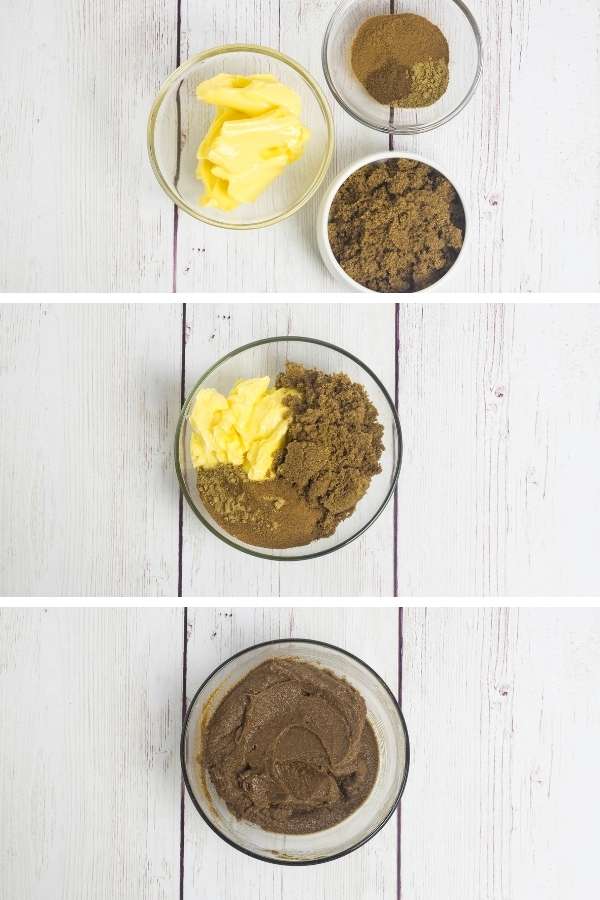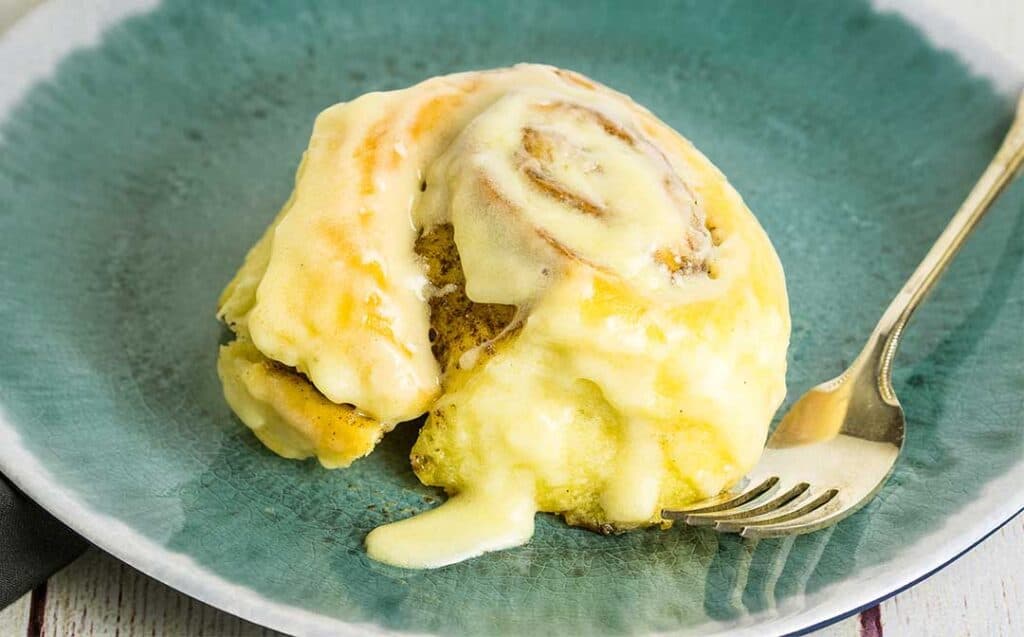This article includes affiliate links. Find out more about affiliate links and how they help this site.
Warm cinnamon rolls are one of life’s great pleasures. Best fresh and soft from the oven, they really need to be baked just before serving for the best flavour and texture. That’s annoying if you want to bake your cinnamon rolls for breakfast – like I do – because they take a while to prepare given all the mixing, rising time and assembly. I don’t want to get up at 4am just to put them on the table for breakfast!
Because I like cinnamon rolls but I don’t like early mornings, I have a system for doing most of the work the day before, then doing the final rise of the assembled rolls overnight in the fridge. The next day, take them out half an hour to an hour before you want to bake, then all you have to do is pop them in the oven, bake, and finish with a rich and sticky cream cheese glaze. I first used this overnight method when I developed the recipe for caramel pecan breakfast scrolls in my Combi Steam Cooking at Christmas cookbook, but it applies well to all sorts of yeast dough recipes.
This prep-ahead method makes cinnamon rolls a quite impressive but easy breakfast or brunch for entertaining, because so much of the work is done ahead that you can relax and enjoy your company instead of slaving in the kitchen. I love serving them for a special occasion breakfast like Christmas morning, when it’s almost compulsory to indulge.

If yeasted doughs are not something you’re experienced with, don’t be daunted! The dough is quite soft and silky, and it doesn’t ‘fight’ you the way some bread doughs do because it’s not as elastic to work with. Gentle hands and just a little patience will reward you with outstanding rolls, far better than you can buy at most bakeries.
I’ve provided both conventional oven and combi steam oven cooking methods here – whichever method you use, they’re quite straightforward and the overnight second rise gives a lot more margin for error when it comes to knowing when your rolls are ready to bake.
Do you want to use and love your steam oven more?
There are precious few resources to teach us HOW to use a steam oven in everyday cooking. I’m guessing that’s why you’re here! If you love cooking but aren’t making the most of your combi steam oven, you aren’t alone.
Steam Oven Insiders was created for you!
Benefit from my decade-plus of steam oven knowledge and training, delivered to your inbox twice monthly in bite sized, easy-to-implement tips and delicious recipes you’ll actually want to cook. Insiders get access to every exclusive recipe and article within the members dashboard, so you’ll never miss a thing.
Find out more right here
Make the dough

Make the filling

Assemble the cinnamon rolls

Make the cream cheese glaze

Happy cooking and if you’re reading this as it’s posted, I hope you have a very Merry Christmas and a Happy New Year. I’ll be taking a couple of weeks off but I’ll be back in January, refreshed and ready to bring you plenty more recipes (and the Combi Steam Cooking for Beginners cookbook!!) for 2019.
See you here again soon.

Overnight Cinnamon Rolls
Ingredients
For the dough
- 1 cup whole milk slightly warmed
- 1 tbs superfine sugar caster sugar
- 2 tsp active dry yeast or instant yeast, see note
- 2 eggs room temperature
- 6 tbs unsalted butter very soft
- 4 cups all purpose flour scant cups, plain flour
- 1 tsp salt
For the filling
- 1/2 cup brown sugar loosely packed
- 1 tbs ground cinnamon
- 2 tsp ground ginger
- 1 tsp allspice
- 1/2 cup unsalted butter 1 stick, very soft
For the cream cheese frosting
- 4 oz cream cheese room temperature
- 1/4 cup unsalted butter softened
- 1 cup confectioners sugar icing sugar
- 1 tsp vanilla extract
- 2 tbs milk
Instructions
Regular Oven Method
- Make the dough: mix the milk and sugar together in a small bowl, then sprinkle the yeast over the top and leave to sit for 5 minutes.
- Put the eggs, butter, flour and salt in the bowl of a stand mixer fitted with the dough hook attachment. Give the yeast mixture a stir and tip into the bowl. Mix on low speed to combine everything for 2 minutes, then increase the speed to medium and mix until smooth and glossy, about 6 minutes. The dough will be very soft, don’t worry if it doesn’t pull away from the sides of the bowl easily.
- Do the first prove: cover the bowl with a damp cloth and set it in a warm place (somewhere that’s around 25°C/75°F is ideauntil doubled in size. Depending on the temperature this should take an hour or two.
- While the dough proves, make the filling by mixing everything together in a bowl. Set aside.
- Assemble the rolls: when the dough has finished the first prove, scrape it out of the bowl onto a floured bench. Gently press to knock out any large air bubbles, then roll it into a rectangle about 40cm/16 inches wide and 30cm/12 inches long. Using your fingers, very gently spread the filling over the dough, squashing it out so there’s a thin, even layer.
- Roll the dough up tightly from the long side, so you have a 40cm/16 inch long spiral. Carefully cut into 12 even pieces with a serrated knife (it’s going to be soft, you may have to gently reshape the rolls after cutting). Lightly grease your baking pan and arrange the rolls evenly into it.
- Prove the rolls: if you want to hold off baking these for up to 12 hours, cover loosely with a plastic bag or cling wrap and pop them in the fridge. Otherwise, cover with a damp cloth and leave in a warm place again to double in size.
- Bake the rolls: If you did the fridge proving method, remove the dish about an hour before you’d like to bake so the rolls can come up to room temperature. Set oven to 190ºC/375ºF, fan forced/convection setting. Bake the rolls until deep golden brown and risen, about 30 minutes. If they’re browning too quickly, cover the dish with aluminium foil partway through cooking. Remove from oven and spread the cream cheese frosting (see beloover the hot rolls – it will melt in slightly and form a glaze as they cool. Serve warm or at room temperature.
Combi Steam Method
- Make the dough: mix the milk and sugar together in a small bowl, then sprinkle the yeast over the top and leave to sit for 5 minutes.
- Put the eggs, butter, flour and salt in the bowl of a stand mixer fitted with the dough hook attachment. Give the yeast mixture a stir and tip into the bowl. Mix on low speed to combine everything for 2 minutes, then increase the speed to medium and mix until smooth and glossy, about 6 minutes. The dough will be very soft, so don’t worry if it doesn’t pull away from the sides of the bowl easily.
- Do the first prove: set your oven to dough proving setting (or steam-only setting, if you don’t have dough proving), 38ºC/100ºPut the uncovered bowl in the oven for 40 minutes, after which the dough should have doubled in size.
- While the dough proves, make the filling by mixing everything together in a bowl. Set aside.
- Assemble the rolls: when the dough has finished the first prove, scrape it out of the bowl onto a floured bench. Gently press to knock out any large air bubbles, then roll it into a rectangle about 40cm/16 inches wide and 30cm/12 inches long. Using your fingers, very gently spread the filling over the dough, squashing it out so there’s a thin, even layer.
- Roll the dough up tightly from the long side, so you have a 40cm/16 inch long spiral. Carefully cut into 12 even pieces with a serrated knife (it’s going to be soft, you may have to gently reshape the rolls after cutting). Lightly grease your baking pan and arrange the rolls evenly into it.
- Prove the rolls: if you want to hold off baking these for up to 12 hours, cover loosely with a plastic bag or cling wrap and pop them in the fridge. Otherwise, set oven to dough proving setting (or steam only settinagain, 38ºC/100ºPut the uncovered dish in the oven for 30 minutes. The rolls should look puffy and be starting to fill out the baking dish.
- Bake the rolls: if you’ve proved your rolls in the oven, you can leave them in there while it heats up. If you did the fridge proving method, remove them about an hour before you’d like to bake so they can come up to room temperature. Set oven to 180ºC/350ºF, combination steam setting (if you have variable steam settings, use 30% – if you can’t vary your steam, just set to combination steam and let the oven take care of the humidity). Bake the rolls until deep golden brown and risen, about 25 minutes. Remove from oven and spread the cream cheese frosting (see beloover the hot rolls – it will melt in slightly and form a glaze as they cool. Serve warm or at room temperature.
Cream cheese frosting
- Mix this up while your cinnamon rolls are baking. Put all the ingredients except the milk into the bowl of a stand mixer and mix on low speed until smooth and creamy. Add the milk with the mixer running, then increase the speed to medium and mix until the frosting is light and fluffy.
Notes
- Makes 12 generous rolls.
- You’ll need a wide, shallow dish for baking these. I use my favourite round 30cm/12 inch low cast iron pan, but a 23x30cm (9×12 inch) baking tray or ceramic dish will work too.
- Although I call these overnight rolls, you can definitely do the whole process in a single session. I’ve provided options for both in the methods below.
- A note on yeast: I use active dried yeast. If you’re using instant, you can skip the first step and just mix the yeast, milk and sugar straight in with the dough. Instant yeast might take a little longer to complete the first prove, so allow anywhere up to 60 minutes.
Nutrition
Over to you – if you try this recipe I’d love to know about it! Please share your pictures with me on Facebook or tag them #whatsinthesteamoven on Instagram.
Would you like more Steam and Bake recipes and steam oven inspiration? Join the mailing list – there’s no spam, just an email every now and then to tell you the latest. When you sign up, you’ll get an invite to the exclusive subscribers-only Combi Steam Cooking Facebook group, which is full of people at all stages of their combi steam journeys, and with many different brands of oven. It’s a friendly, helpful space to learn and share with one another, and I’m always in there answering questions and sharing tips.
And if you’re after more delicious recipes for yeasted doughs, try the ridiculously rich Chocolate, Pecan and Burnt Caramel Monkey Bread, the more ‘everyday’ but just as delicious Spiced Apricot, Date and Seed Bread, or one of the site’s most popular recipes this year, New York Style Bagels.



If you have a hand mixer with a dough hook attachment the directions will be pretty much the same; it’s less about the mixing time and more about making a soft, silky, smooth ball of dough, if that makes sense. Some hand mixers will struggle with the time needed to get to that point, it depends on the motor of your mixer. And I would not make the dough with a hand mixer that has the beater attachments as you’ll make a mess of both dough and mixer. You can mix the dough for these by hand if you’re really invested in making them! To do that, mix with a spatula or a large metal spoon until you’ve got a mass of dough, then turn it out and knead until it’s silky soft. If you’re kneading by hand it helps to have a cool room and to use a marble board or countertop, to keep the dough cool while you knead it.
What if I don’t have a “bowl mixer”? Can I still make these using a hand mixer? If so, what are the modified directions? I REALLY want to make these! Thanks!!
If you’re finding the dough is too soft to make the filling easily spreadable, you can chill the dough rectangle for 15-20 minutes before spreading out the filling. I tend to do this in the hotter months here.
Love this recipe! I live at high altitude (9K’) so I made a few minor adjustments — and they came out perfect! I struggled with one part of the preparations: spreading the filling onto the rectangle of proofed dough. Do you have a secret method you could share?
Hi,
What would I change to make these into mini cinnamon rolls?
Thank you in advance!
Thank you for the response, Emily!
I experimented with freezing methods for “make ahead” options. Here are some notes in case someone else is trying this…
I tried two methods (both freezing for 2 days just to test)…freezing before the second rise and freezing after a partial bake. We preferred the latter as we got the benefits of the convection-steam as much as possible (second rise, oven spring, and baking with conv-steam). It matters in this instance since they will travel with us frozen and be warmed through/finish baking at my parents’ home in their “regular” oven.
As far as the first method (freeze pre second rise), they didn’t really thaw to fridge temp in 6 hours in the fridge so I took them out for a couple hours before bed to help them come up to fridge temp. After a night in the fridge they hadn’t risen at all so I abandoned my experiment as far as finishing those particular rolls in an oven like may parents’. Instead I just followed the steam oven recipe section and did a partial second rise at 100 degrees F, steam. They ended up almost as good as usual, but I prefer making them per your instructions straight through. (It’s possible that I left them unprotected in the freezer on a sheet tray too long in my efforts to make sure they didn’t freeze stuck together…as I was then bagging to save space…this might have dried out the surface too much and inhibited their fridge rise.)
Thank you for all your hard work!! I love your cookbooks and really appreciate all the experimenting you’ve done so that I can enjoy my CSO!
Yes, they can! Just remember the yeast is still (minimally) active even when frozen, so I wouldn’t make them more than a week out or you won’t get as nice a texture in the finished rolls. A day and a half in the fridge should be about right for thawing, though.
Do you think these can be frozen at step 7 if I need to make them a week out from baking? And then thaw half a day plus over night int he fridge for the second rise??
Excellent recipe, not cloyingly sweet and baked up beautifully in the Anova steam oven. Thank you!
This recipe is stunning, the whole family ate them all in the one sitting!!!
Great article 🙂